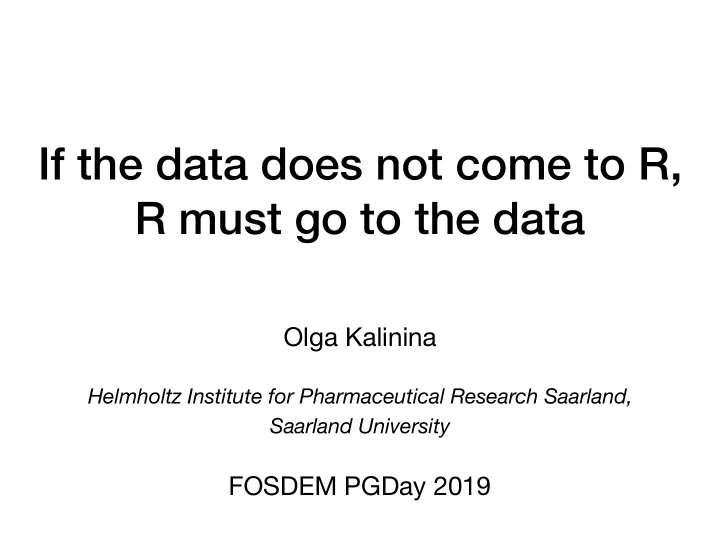

Mutations • Happen in DNA • Sources: • Spontaneous mistakes of DNA polymerase • Endogenous DNA damage • Exogenous DNA damage � 14
Mutations • Happen in DNA • Sources: • Spontaneous mistakes of DNA polymerase • Endogenous DNA damage • Exogenous DNA damage • Repair mechanisms => 1 mutation in 10 10 nucleotides per cell division � 14
Mutations • Happen in DNA • Sources: • Spontaneous mistakes of DNA polymerase • Endogenous DNA damage • Exogenous DNA damage • Repair mechanisms => 1 mutation in 10 10 nucleotides per cell division • Cf. human genome size: 3 × 10 9 bp � 14
The Central Dogma: flow of information in the living cells
The Central Dogma: flow of information in the living cells https://commons.wikimedia.org/wiki/File:Central_dogma_of_molecular_biology.svg
The Central Dogma: flow of information in the living cells https://commons.wikimedia.org/wiki/File:Central_dogma_of_molecular_biology.svg
The Central Dogma: flow of information in the living cells https://commons.wikimedia.org/wiki/File:Central_dogma_of_molecular_biology.svg
The Central Dogma: flow of information in the living cells https://commons.wikimedia.org/wiki/File:Central_dogma_of_molecular_biology.svg
Protein thermodynamic stability
Protein thermodynamic stability • Simple case: protein can unfold and refold rapidly, reversibly, via a two-state mechanism
Protein thermodynamic stability • Simple case: protein can unfold and refold rapidly, reversibly, via a two-state mechanism • Δ G = G unfolded − G folded
Protein thermodynamic stability • Simple case: protein can unfold and refold rapidly, reversibly, via a two-state mechanism • Δ G = G unfolded − G folded • Upon mutations, Δ G can change: ΔΔ G = Δ G mut − Δ G WT
Protein thermodynamic stability • Simple case: protein can unfold and refold rapidly, reversibly, via a two-state mechanism • Δ G = G unfolded − G folded • Upon mutations, Δ G can change: ΔΔ G = Δ G mut − Δ G WT https://commons.wikimedia.org/w/index.php?curid=28353539
Some data (real-life) • ΔΔ G estimates upon mutations #chr Gene ClinicalSignificance uniprot_ac uniprot_pos aa1 aa2 FX_ddG chr1 ISG15 Benign P05161 83 S N -0.517133 chr2 DNMT3A Pathogenic Q9Y6K1 583 C Y 33.0787 chr1 AGRN Benign O00468-6 15 P R ? … • 84,426 rows (13 MB) � 17
Reading the data (R) > x<-read.table("clinvar.main.pph.ddg.uniprot.tsv", sep=‘\t’, header=T) > x[ x == “ ? ” ] <- NA > nrow(x) 84426 • => data frame � 18
Reading the data (Postgres) kalinina=# CREATE TABLE clinvar (chr text, to1 bigint, ref text, alt text, GeneSymbol text, ClinicalSignificance text, ReviewStatus text, PhenotypeList text, uniprot_ac text, uniprot_pos int, aa1 char(1), aa2 char(1), prediction text, PDB_id text, PDB_pos text, PDB_ch char(1), ident float, FX_ddG float, IM_ddG float, M_ddG float, M_conf float); CREATE TABLE kalinina=# COPY clinvar FROM 'clinvar.main.pph.ddg.uniprot.tsv' WITH (NULL ' ? ', DELIMITER E'\t' ); COPY 84426 � 19
Calculate median (R) >median(x$FX_ddG) [1] NA � 20
Calculate median (R) >median(x$FX_ddG) [1] NA >median(x$FX_ddG, na.rm=TRUE) [1] 0.974858 � 21
Calculate median (R) >median(x$FX_ddG) [1] NA >median(x$FX_ddG, na.rm=TRUE) [1] 0.974858 >(x[x$ClinicalSignificance==‘Pathogenic',]$FX_ddG) [1] 1.7756 � 22
Calculate median (R) >median(x$FX_ddG) [1] NA >median(x$FX_ddG, na.rm=TRUE) [1] 0.974858 >(x[x$ClinicalSignificance==‘Pathogenic',]$FX_ddG) [1] 1.7756 > aggregate (FX_ddG ~ ClinicalSignificance, data = x, FUN = median) ClinicalSignificance FX_ddG 1 Benign 0.62209 2 Pathogenic 1.77560 � 23
Calculate median (PL/R) kalinina=# CREATE or REPLACE FUNCTION r_median(_float8) RETURNS float AS ' median(arg1) ' LANGUAGE 'plr'; CREATE FUNCTION kalinina=# CREATE AGGREGATE median ( sfunc = plr_array_accum, basetype = float8, stype = _float8, finalfunc = r_median ); CREATE AGGREGATE kalinina=# SELECT clinicalsignificance, median(fx_ddg) FROM clinvar GROUP BY clinicalsignificance ORDER BY clinicalsignificance; clinicalsignificance | median ---------------------+---------- Benign | 0.6220875 Pathogenic | 1.7756 (2 rows) � 24
Summary statistics (R) > aggregate(FX_ddG ~ ClinicalSignificance, data = x, FUN = summary) ClinicalSignificance FX_ddG.Min. FX_ddG.1st Qu. FX_ddG.Median FX_ddG.Mean FX_ddG.3rd Qu. FX_ddG.Max. 1 Benign -5.77969 -0.04082 0.62209 1.37172 1.91954 62.08970 2 Pathogenic -18.09830 0.30438 1.77560 3.21887 4.21793 52.26050 � 25
Summary statistics (R) > aggregate(FX_ddG ~ ClinicalSignificance, data = x, FUN = summary) ClinicalSignificance FX_ddG.Min. FX_ddG.1st Qu. FX_ddG.Median FX_ddG.Mean FX_ddG.3rd Qu. FX_ddG.Max. 1 Benign -5.77969 -0.04082 0.62209 1.37172 1.91954 62.08970 2 Pathogenic -18.09830 0.30438 1.77560 3.21887 4.21793 52.26050 > aggregate(FX_ddG ~ ClinicalSignificance, data = x, FUN = summary) ClinicalSignificance FX_ddG.Min. FX_ddG.1st Qu. FX_ddG.Median 1 Benign -5.77969 -0.04082 0.62209 2 Pathogenic -18.09830 0.30438 1.77560 FX_ddG.Mean FX_ddG.3rd Qu. FX_ddG.Max. 1.37172 1.91954 62.08970 3.21887 4.21793 52.26050 � 26
Summary statistics (R) > aggregate(FX_ddG ~ ClinicalSignificance, data = x, FUN = summary) ClinicalSignificance FX_ddG.Min. FX_ddG.1st Qu. FX_ddG.Median FX_ddG.Mean FX_ddG.3rd Qu. FX_ddG.Max. 1 Benign -5.77969 -0.04082 0.62209 1.37172 1.91954 62.08970 2 Pathogenic -18.09830 0.30438 1.77560 3.21887 4.21793 52.26050 > aggregate(FX_ddG ~ ClinicalSignificance, data = x, FUN = summary) ClinicalSignificance FX_ddG.Min. FX_ddG.1st Qu. FX_ddG.Median 1 Benign -5.77969 -0.04082 0.62209 2 Pathogenic -18.09830 0.30438 1.77560 FX_ddG.Mean FX_ddG.3rd Qu. FX_ddG.Max. 1.37172 1.91954 62.08970 3.21887 4.21793 52.26050 You need additional code if you need to preserve a specific order of categories � 27
Summary statistics (PL/R) kalinina=# CREATE or REPLACE FUNCTION r_summary(_float8) RETURNS _float8 AS ' summary(arg1) ' LANGUAGE 'plr'; CREATE FUNCTION kalinina=# CREATE AGGREGATE summary ( sfunc = plr_array_accum, basetype = float8, stype = _float8, finalfunc = r_median ); CREATE AGGREGATE kalinina=# SELECT clinicalsignificance, SELECT summary(fx_ddg) FROM clinvar GROUP BY clinicalsignificance ORDER BY clinicalsignificance; clinicalsignificance | summary ---------------------+-------------------------------------------------------------------- Benign | {-5.77969,-0.040819875,0.6220875,1.37171750416516,1.9195375,62.0897} Pathogenic | {-18.0983,0.3043845,1.7756,3.21886833468419,4.217925,52.2605} (2 rows) � 28
Boxplot (R) >boxplot(x[ x$ClinicalSignificance == ‘Pathogenic’, ]$FX_ddG) � 29
Boxplot (R) >boxplot(x[ x$ClinicalSignificance == ‘Pathogenic’, ]$FX_ddG) >boxplot(x[ x$ClinicalSignificance == ‘Pathogenic’, ]$FX_ddG) � 30
Boxplot (R) >boxplot(x[ x$ClinicalSignificance == ‘Pathogenic’, ]$FX_ddG) >boxplot(x[ x$ClinicalSignificance == ‘Pathogenic’, ]$FX_ddG) • Syntax for subsetting: x[ x $ <someFactor> == ‘<someValue>’ , ] � 30
Recommend
More recommend